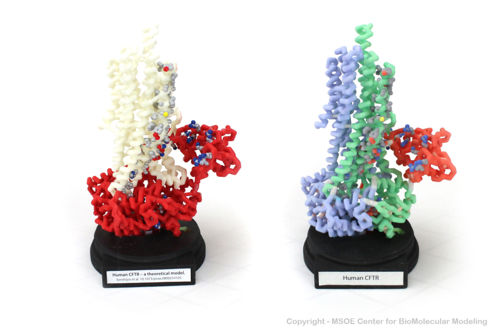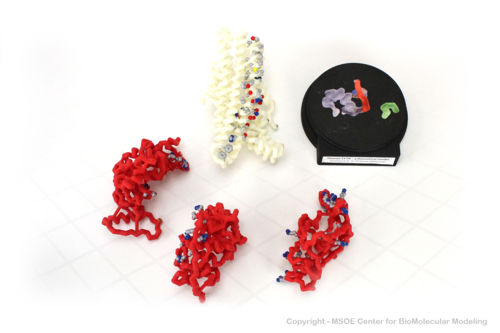Cystic fibrosis transmembrane conductance regulator (CFTR)
From Proteopedia
(Difference between revisions)
m |
m |
||
| (8 intermediate revisions not shown.) | |||
| Line 5: | Line 5: | ||
CFTR is a mostly <scene name='78/785332/Secondary_structure/1'>alpha helical</scene> protein. The membrane spanning segments can be clearly seen with coloring by <scene name='78/785332/Hydrophobicity/1'>hydrophobicity</scene>, which shows hydrophobic residues in gray and hydrophilic residues in purple. | CFTR is a mostly <scene name='78/785332/Secondary_structure/1'>alpha helical</scene> protein. The membrane spanning segments can be clearly seen with coloring by <scene name='78/785332/Hydrophobicity/1'>hydrophobicity</scene>, which shows hydrophobic residues in gray and hydrophilic residues in purple. | ||
| - | The extracellular end of the channel has several <scene name='78/785332/Ec_cl_selection/1'>positively charged</scene> residues that are important for recruiting chloride ions to the channel. A number of <scene name='78/785332/Plus_channel/1'>positively charged</scene> residues line the channel. In the unphosphorylated state (as this structure is), a <scene name='78/785332/Regulatory_domain/2'>regulatory domain</scene> blocks the activity of the channel (the connecting segments are not visible in the structure). It contains several negatively charged residues; when the protein is phosphorylated, this segment is repelled, causing a structural change. <ref>PMID:28340353</ref> | + | The extracellular end of the channel has several <scene name='78/785332/Ec_cl_selection/1'>positively charged</scene> residues that are important for recruiting chloride ions to the channel. A number of <scene name='78/785332/Plus_channel/1'>positively charged</scene> residues line the channel. In the unphosphorylated state (as this structure is), a <scene name='78/785332/Regulatory_domain/2'>regulatory domain</scene> blocks the activity of the channel (the connecting segments are not visible in the structure). It contains several negatively charged residues; when the protein is phosphorylated, this segment is repelled, causing a structural change. <ref>PMID:28340353</ref> In the unphosphorylated state, P99,G103,R104,R334,K335,F337,N1138 <scene name='78/785332/Blocked_channel/1'>block the channel</scene>; in the <scene name='78/785332/Phosphorylated_pore/1'>phosphorylated state</scene>, these amino acids are moved out of the way, creating a pore large enough for a chloride ion to move through the channel. |
| - | CFTR contains two Walker motifs, | + | CFTR contains two <scene name='78/785332/Nbd/2'>nucleotide binding domains</scene> (NBD's), which both contain <scene name='78/785332/Walker_motifs/2'>Walker motifs</scene>, flexible loops that bind phosphate groups tightly and are highly conserved among ATP-binding proteins. |
| + | |||
| + | ==Mutations in Cystic Fibrosis== | ||
| + | |||
| + | Cystic fibrosis is characterized by decreased chloride transport, which causes mucus to be thicker and stickier. This leads to a variety of problems, including decreased lung capacity, decreased pancreatic enzyme release into the small intestine, increased rates of lung infections, and infertility.<ref>https://ghr.nlm.nih.gov/condition/cystic-fibrosis</ref> There are a wide assortment of mutations that cause cystic fibrosis, with differing symptom severity. The deletion of <scene name='78/785332/F508/1'>F508</scene> causes the protein to not be properly synthesized, and no expression is seen on the cell surface. Other mutations are found in the NBD's; some of these mutations such as S1255P alter the responsiveness to MgATP, while others such as G551S, G1244E, and G1239D decrease the frequency of channel opening. | ||
| + | |||
| + | Some of the mutations that lead to cystic fibrosis are due to folding errors. There are <scene name='78/785332/Numbered_bundles/2'>12 transmembrane sequences</scene> in CFTR; they are not sequential in their packing. The presence of <scene name='78/785332/Numbered_bundles_pos_res/1'>hydrophilic, positively charged amino acids</scene> in these transmembrane sequences (shown in red) lead to a folding problem: how do you stabilize them until they can be protected by hydrophobic residues and are no longer exposed to the hydrophobic membrane? | ||
==3D Printed Physical Model of the CFTR protein== | ==3D Printed Physical Model of the CFTR protein== | ||
| Line 27: | Line 33: | ||
== References == | == References == | ||
<references/> | <references/> | ||
| + | |||
| + | [[Category:3D printer files]] | ||
Current revision
Cystic fibrosis transmembrane conductance regulator (CFTR)
| |||||||||||
References
- ↑ Liu F, Zhang Z, Csanady L, Gadsby DC, Chen J. Molecular Structure of the Human CFTR Ion Channel. Cell. 2017 Mar 23;169(1):85-95.e8. doi: 10.1016/j.cell.2017.02.024. PMID:28340353 doi:http://dx.doi.org/10.1016/j.cell.2017.02.024
- ↑ https://ghr.nlm.nih.gov/condition/cystic-fibrosis



